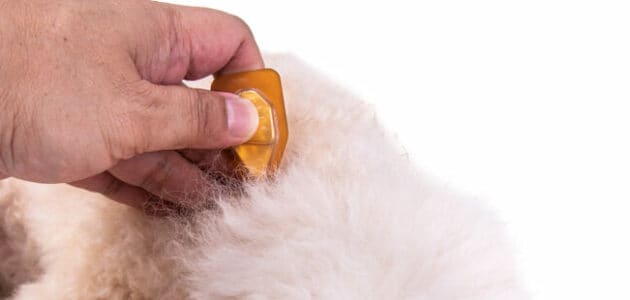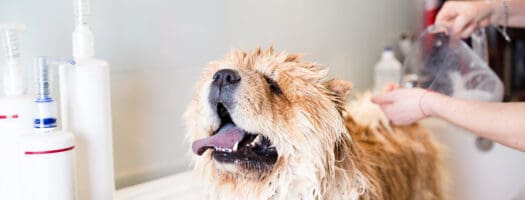Dog Safety: Peppermint Oil & Other Toxic Essential Oils

When it comes to feeding and care, most dog owners know that there are some pretty important do’s and don’ts when it comes to what you can and cannot give your beloved companion. Sometimes it can seem like there’s a never-ending laundry list of unsuspecting food and ingredients that are potentially life-threatening if they wind up in your pooch’s mouth. From garlic and onions to raisins and chocolate, there are very many inconspicuous foods that could potentially be fatal for pups.
Essential oil lovers beware: peppermint oil (among other oils) is unfortunately also on that list. With essential oils now becoming an increasingly popular trend among home and pet owners, it’s important to educate yourself on why certain substances and foods are unsafe for dogs, what oils are safe and unsafe, and what to do if your dog suffers peppermint poisoning.
What Are Essential Oils?
With the huge rise in popularity of essential oils, peppermint oil is quickly becoming a relatively common household substance. The use of essential oils has been on a steady incline in homes around the world, meaning more and more people are keeping these strong and fragrant oils within reach of their pets.
Essential oils are extremely concentrated and fragrant oils that come from flowers, plants, herbs, and citrus fruits. Commonly used in bath and beauty products, these oils have gained a lot of popularity among people interested in aromatherapy and scent diffusion. Essential oil diffusers have become a must-have item for people who want to add a touch of fragrance and aromatherapy into their homes.
What Is Aromatherapy?
Aromatherapy is a practice of wellness that has been used in many different cultures across the globe for thousands of years. A holistic approach to mental and physical health and wellness, aromatherapy is the targeted use of specific fragrances to heal, calm, and treat ailments and afflictions of the mind, body, soul, and spirit.
When delving into essential oils and aromatherapy, it’s important to know how to use each scent for its desired effect. Scents like lavender and vanilla promote relaxation, citrus oils awaken and revive, jasmine and rose help with peaceful sleep, and eucalyptus and mint cleanse and refresh.
Although essential oils can provide many great benefits to the body, you should never ever apply concentrated essential oils directly on to any part of the skin. Their highly concentrated nature makes them an extremely volatile substance and can inflict painful damage to the skin, face, and eyes. To safely use topically on humans, they should be significantly diluted by water or another soluble substance such as a glycerin based soap, lotion, or bath product. But what about using them on your dog?
Can Essential Oils Work for Your Dog?
There are two main ways people considering using essential oils for their dog: either by applying the oil directly to the dog’s skin or fur, or through aromatherapy.
Applying Essential Oils Directly
Peppermint oil has historically been used an insect repellant. Because of this, some people believe that applying peppermint oil directly to a dog’s skin can kill fleas and ticks. Unfortunately, it’s not true – peppermint oil itself cannot kill insects. There is a chance that it could work as a flea and tick repellant, but the potentially-deadly health risks to your dog are not worth it.
There is some evidence that peppermint oil may help dogs suffering from rashes and inflammation resulting from allergies, infestations, or other skin irritations. However, peppermint oil can actually cause an allergic reaction or skin irritation, so it’s not a consistently safe or productive method.
If you notice your dog is suffering from skin ailments or insect infestations, it’s best to take them to a vet and have them to prescribe a safe, effective treatment,
Aromatherapy and Dogs
Since the use of aromatherapy and essential oils in humans has been so popular, it was only a matter of time before people started to experiment with aromatherapy for their pets. But is it safe? It seems the answers are conflicting.
Some people have said there are many benefits of using aromatherapy on dogs. Dogs have an incredibly powerful and sensitive olfactory system, meaning their sense of smell is about 40 times better than a human’s. Some people believe because of this, aromatherapy is even more beneficial and effective for them because this system is such a major and integral part of their body.
On the other hand, others will say it’s not worth the risk. While not of them are, there are many different essential oils that are potentially harmful for your pup and some believe it may be a better idea to keep them away from the oils altogether. Dangerous exposure to these harmful oils can result in symptoms such as vomiting, diarrhea, lethargy, weakness, depression, varying extremes in body temperature, excessive drooling, muscle tremors, and difficulty with walking and coordination.
When doing aromatherapy for yourself or your pet, it is very important to know which essential oils are safe to use around dogs, and which ones are toxic.
Some of the most toxic essential oils to keep away from your dog include:
– Peppermint
– Wintergreen
– Pennyroyal
– Cinnamon
– Citrus (lemon, orange, lime, bergamot, grapefruit, etc.)
– Eucalyptus
– Tea tree
– Sweet birch
– Pine
– Ylang ylang
Many of these oils are now popularly being used via air diffusion. Air diffusion (done by using an essential oil diffuser) dilutes the essential oil in water and then evaporates it, allowing tiny particles of the concentrated oil to be thrown into the surrounding air. This will make the room smell amazing and delivers all the positive effects of aromatherapy, but it will also inevitably land on your pet’s fur.
Since most pets clean themselves by licking their own fur, it’s possible for them to ingest a significant amount of the toxic essential oil this way. This is a very dangerous way for your dog to come in contact with these oils. Over time, the amount of oil they ingest will slowly increase without you even knowing, and the signs of poisoning will slowly being to occur.
In many unfortunate cases, dog owners were not able to attribute the signs of poisoning to their essential oil diffuser because they had been using it for some time without any adverse effects. The slow buildup of poisoning can be even more dangerous because it makes it harder for owners to pinpoint the exact cause.
What Essential Oils Are Safe to Use Around Dogs?
Thankfully, there are some safe essential oils that you can use around your dogs at home, which include:
– Anise
– Yarrow
– Juniper
– Clove
– Thyme
– Chamomile
– Frankincense
– Ginger
– Lavender
– Myrrh
While these are safe to use during essential oil diffusion and responsible aromatherapy, contact with any undiluted essential oils is dangerous for both pets and humans alike. Be sure to never apply concentrated oil to your dog’s fur, paws, ears, or nose. If contact does happen, make sure to immediately wash it off the affected area with cold water. If any signs of poisoning arise, contact your local veterinarian right away.
Peppermint Oil and Peppermint Poisoning
The peppermint plant is a member of the mint (or mentha) family. All members of the mint family should vigilantly be avoided by dogs when it comes to both direct consumption and air diffusion.
What Benefits Does Peppermint Oil Have for Humans?
Within aromatherapy, the scent of peppermint is said to aid in relaxation, clarity, energy, memory, concentration, and wakefulness. Peppermint oil has also commonly been used for different physical ailments of the body and can help with things such as colds, clogged sinuses, and nausea. When used in a lotion, balm, or salve, it is also said to be helpful for muscle soreness, body aches, and general temporary pain relief.
What Does Peppermint Oil Do to Dogs?
While consuming a small amount of peppermint will not be instantly fatal to your pooch, it can cause a lot of other internal problems. Eating even small quantities of peppermint can cause an upset stomach, vomiting, diarrhea, and lethargy. Consumed in large quantities could pose much greater risks to your dog’s health and should always be taken seriously and immediately addressed by a veterinary professional.
If you know that your dog has consumed large quantities of peppermint, watch out for signs of peppermint poisoning. Signs of peppermint poisoning include lethargy, confusion, vomiting, diarrhea, muscle tremors, and spasms.
If your dog is exhibiting any of these dangerous signs, please call your local veterinarian as soon as possible. In the most severe cases (or if your dog has ingested pennyroyal mint in particular) this poisoning can result in liver failure, organ failure, permanent organ damage, and even death.
What Is the Safest Way to Use Peppermint Oil Around Your Dog?
While many pet owners and aromatherapy enthusiasts have good intentions, it’s important to be aware of what could potentially be life-threatening for your dog. Essential oils may be helpful for human conditions but they should be used with extreme caution when it comes to dogs. Essential oil diffusers should be used with careful thought and only with essential oils that are deemed safe to use around dogs. Even better, they should be kept in rooms or areas of the house where dogs have the least amount of easy access.
If you were thinking about using aromatherapy for your dog to calm them or heal some kind of ailment, please do so responsibly. It’s incredibly important to ensure that if you are going to use essential oils around your dog, you are using the highest quality oils you can. Cheap and impure essential oils can contain dangerous synthetic or artificial additives. Some of the plants or flowers these oils were derived from could have even been exposed to chemicals or pesticides before being manufactured into an oil. These additives or chemicals can create an even more toxic and dangerous substance that will pose a greater risk of harm for your dog (and yourself included. You deserve better than that, too!)
What Else is Dangerous for Dogs to Ingest?
Dogs (as well as all other domestic animals) have very different digestive systems to humans. This makes certain foods that are safe for us to eat incredibly dangerous for them to eat. For example, humans regularly consume foods that contain methylxanthines, a substance found in chocolate, coffee, and caffeine. While this is harmless to us, if it is ingested by a dog it can cause diarrhea, vomiting, excessive thirst and urination, hyperactivity, abnormal heartbeat, seizures, tremors, and in the worst cases, even death.
Unfortunately, this adverse reaction also applies to many other foods, ingredients, substances, and chemical compounds found in our everyday foods.
Other foods, ingredients, and substances that are unhealthy or unsafe for dogs that should be avoided include:
– Alcohol
– Artificial sweeteners (especially xylitol)
– Avocado
– Citrus fruits and oils
– Coconut and coconut oil
– Dairy (milk, cheese, yogurt, sour cream, ice cream, etc.)
– Excess salt
– Excess sugar
– Grapes and raisins
– Gum, candy, and chocolate
– Hops (used in beer brewing)
– Nuts
– Onions, garlic, chives, and shallot
– Pits and seeds (apple seeds, apricot pits, cherry pits, peach pits, etc.)
– Plant leaves and stems (mushrooms, potatoes, tomatoes, rhubarbs, etc)
– Tea and coffee (or anything containing caffeine)
– Yeast
The digestive and immune systems of canines cannot properly process the same chemical compounds that humans can. This makes a lot of food and common household substances especially dangerous if left out for curious and determined dogs to get into. While all of these foods and ingredients are not immediately fatal, they can be extremely unhealthy for them and can cause a lot of sickness, pain, and discomfort for your pet.
With all the kitchen ingredients that are unsafe for dogs, there is another hidden threat in the home that must be considered: essential oils.
Keep Your Dog Safe by Avoiding Peppermint Oil
If you decide you don’t want to take the risk of aromatherapy but still want to do something calming for your dog, consider other safe options such as pet CBD, anxiety vests, behavioral training, and safe medications prescribed by your dog’s vet. Dogs are an important and loving part of many of our families, and their health is of the utmost importance to us all.
Make sure you’re always doing your proper research before introducing any foreign food, substance, ingredient, or medication to your dog. There are many hidden toxins in the home that could be dangerous to dogs and the more dog owners are educated about them, the more dogs will be saved from unnecessary and avoidable pain, sickness, and death.
While peppermint oil is great to use for aromatherapy for humans, it should always be avoided when it comes to your beloved furry friend.




